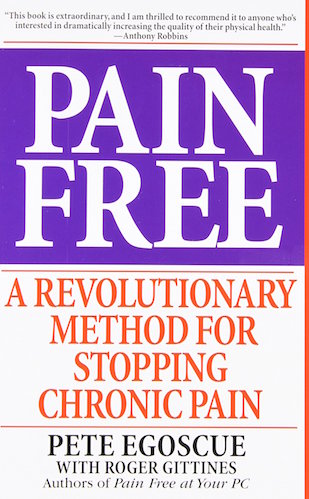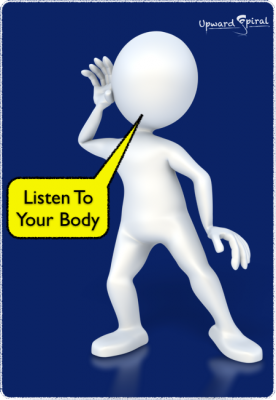If you’re like most people who have read Pain Free by Pete Egoscue, you probably had a lightbulb go on when you did so. You also quite likely feel like you’ve found the answer to your pain problems.
And hopefully you have.

Something I’ve noticed with people who’ve read Pain Free is they can sometimes be so taken in by the language and the ‘simplicity’ of what Pete talks about, that they subjugate themselves to his words.
I've heard various comments on so many occasions from people that have read Pain Free that it's become quite clear there are times when their experience is telling them something different to what they've read, yet they continue to 'push on and hope it gets better', such are the power of words.
So here are my three top tips for getting the most from Pain Free by Pete Egoscue (and from any exercise program in general):
More...
Pain Free Tip #1: Pay Close Attention To Your Alignment and Form
Your alignment and positioning when you do the exercises is really important and while you don’t need to spend longer getting yourself into position than you do on the exercise itself, you will achieve more by spending a little bit of time checking that you’re in good alignment before you begin.
So here are the key suggestions:
Where it says to have your feet straight, make sure your feet are straight!
Pretty obvious, right?!
Yet it’s one the most common mistakes I see people making. Before you start the actual exercise itself, just take a few moments to look down at your feet and get them straight.
Be sure to get them straight on both sides too!
Again, that should be obvious and sometimes it gets forgotten. If one foot is straight and the other is turned out, that will translate further up the chain into your pelvis and upper body.
While it might appear trivial, it can make a big difference.
Remember, the goal here is to get you in better alignment on an ongoing basis. So start by being in good alignment as you do the exercises that place a functional demand on your body to bring about those long term changes.
Where it says to have your feet and knees hip width apart, the most common error I see is that people stand with their feet too wide.
Usually these folks place their feet pelvis width apart rather than hip width. So what’s the difference?
Your hip joint is where your thigh bone (Femur) meets your pelvis. If you gently poke the crease in your groin, that’s roughly where it is (slightly more than a ‘fist width’ apart).
You might think your hips are where you put your hands when you ‘put your hands on your hips’, and given that expression, it’s understandable why.
That’s actually the outside of your pelvis, though, and not your hip joints. I know, it’s a bit confusing.
Pay close attention to the subtleties of the instructions.
If an exercise calls for you to “tighten your thighs (Quads) and flex your feet back towards your shins”, for example, then remember to do so.
Putting yourself in the correct position but not following these nuances in the instructions will yield suboptimal results. These instructions are really important to the outcome of the exercise you're doing.
Using that example of tightening your thighs (Quads) and flexing your feet back towards your shins as an example, when you do this you are:
- Engaging muscles that need to be engaged to achieve the desired outcome
- Invoking a mechanism known as ‘Reciprocal Inhibition’, which utilizes opposing muscle groups to restore balance
- Affecting the entire kinetic chain, which helps to ‘bring online’ other muscles that were previously ‘offline’ and get your body working as a unit
Pain Free Tip #2: Avoid Cherry Picking
 The goal of any corrective exercise program should be to take your body from where it is right now and to elicit structural and functional changes that bring about a greater sense of well being and increased efficiency of movement.
The goal of any corrective exercise program should be to take your body from where it is right now and to elicit structural and functional changes that bring about a greater sense of well being and increased efficiency of movement.
As such, each exercise is carefully selected and sequenced in the appropriate order to achieve that outcome. This rule is no different for the exercises in Pain Free.
There are probably two main reasons that you might want to ‘cherry pick’ exercises and leave the rest out, which are:
– You don’t feel much happening, so deem it to be a pointless exercise
Some exercises in Pain Free, and corrective exercises in general, are so gentle that it feels as though not much is happening. Even though it may appear not much is happening, it is unwise to skip them.
There has been such a conditioning of our minds by the media over the last few decades that if it doesn’t ‘burn and make us tremble and sweat’, it can’t be doing any good.
Remember not to confuse corrective exercises with a workout at the gym. They are very different entities.
Many of these so called gentle exercises are very powerful ‘under the hood’ and are often the ‘glue that holds it all together’.
– The other reason you might want to cherry pick is because the exercise is too difficult
In that case, again, it’s important that you communicate with the person who gave you the exercise.
When I’m creating a program of corrective exercises for any client, one of the things I’m keeping in mind is to make the selection challenging for them, but not too difficult for them.
Corrective exercises often have stepwise progressions, and the particular selection given to you should find the balance between being challenging enough to stimulate your body into adapting and changing, but not so demanding that you are unable to complete it without compensation and/or without losing hope of ever progressing.
It’s important to keep in mind where a person is at emotionally as well as physically when creating corrective exercise programs too.
Of course, if you’re working by yourself from Pain Free by Pete Egoscue and you don’t have a therapist to communicate with, then my suggestion is to use your own judgement.
If it’s an exercise that needs to be held for a length of time and you can only do, say, a minute, but no longer, then do just a minute.
You’ll find that over the course of a week or two, you can gradually increase the time held. There’s no point forcing yourself to hold a position for three minutes if you simply can’t hold it.
Remember to make it challenging for yourself, but not too demanding.
Pain Free Tip #3: Listen To Your Body
 I’ve had two clients relatively recently who have encountered problems with a particular exercise in one of the Pain Free ‘menus’ and, despite their body telling them quite clearly not to do those exercises, they’ve ‘soldiered on’ because “Pete rates it highly as a good exercise, so it must be good”.
I’ve had two clients relatively recently who have encountered problems with a particular exercise in one of the Pain Free ‘menus’ and, despite their body telling them quite clearly not to do those exercises, they’ve ‘soldiered on’ because “Pete rates it highly as a good exercise, so it must be good”.
Now, as far as self help books that are currently on the market go, Pain Free by Pete Egoscue is far and away the best. Having said that, I can’t emphasise enough that while it is a good book, it is still only a book.
Which means that, by its very nature, it is generic and the ‘menus’ of exercises in it are also generic.
The menus of exercises in Pain Free are written based on Pete Egoscue’s experience of working with many people over the course of three decades who exhibit similarities in their posture.
I don’t know for sure, but my guess is that when Pete wrote that book, he sketched out the ‘typical’ person for each symptom. And then, based on that “typical” person, he created the appropriate ‘menu’ of exercises.
Remember, you are not that typical person. You are YOU!
If an exercise hurts or leaves you in pain after you’ve done it, then that exercise is not appropriate for your body right now.
Regardless of who gave it to you.
When it comes to labelling an exercise as a “good exercise” or not, there a few criteria that need to be met, one of which is:
Does the exercise make you feel and look better afterwards?
If you feel worse afterwards (increased pain etc) then, by definition, that exercise is not a good exercise for you; right now at least.
If you ever listened to Pete when he had his radio show between 2001 and 2009, you’ll probably remember one of his favorite phrases was, “Trust your instincts; you know your body better than anyone else in the whole wide world”.
And he would tell you the same as I am telling you now: If an exercise causes you pain, stop doing that exercise immediately!
If it was given to you directly by a therapist, then communicate with that therapist so he can make the necessary adjustments to your program and get you moving in the right direction again.
Quite often, all it takes is the addition of another exercise prior to the ‘offending’ exercise to set your body up for it, and/or the addition of another exercise afterwards to bring you out of it properly (and sometimes it means removing that exercise completely until your body is ready for it).
Pain Free Bonus Tip: Continue After You’ve Achieved Pain Free Status
If you imagine pain in your body as being like a fire in a building, and then you imagine corrective exercises – in the initial stages – as being like water to put the fire out, then once the fire is extinguished, does that mean the problem is fixed?
Well, if it was your office, school or home that just had a fire in it, would you move back in straight after the fire was extinguished?
Probably not.
You’d probably have to do some work on the place first like tidying up, fixing whatever is broken and then painting and decorating to get it back to looking good as new.
Treat your body the same as you would treat your fire damaged home and don’t just stop once the fire is out. Instead, get the painters and decorators in and design it exactly how you want it to look.
Instead of stopping when you’ve achieved the absence of pain, continue on so you can achieve the absence of limitations.
Pain is your body’s last attempt at alerting you to a problem. So once the pain is gone, continue to listen to your body’s other voices and you’ll hear that it was always communicating its needs to you long ago.
What tips would you add to the ones suggested here? Now you’ve read Pain Free by Pete Egoscue, what would you have included here?
Please leave a comment to let me know.

Great stuff Matt! Hope you’re well buddy.
Hey Dan,
Thanks!
Good to hear from you and I’m glad to hear you’re in training to help folks with their muscle and joint pain too.
Good luck with that!
Another GREAT post Matt! Love it – and will definitely be including it as a reference article in my resource center to share with others!
Thanks so much!
Thanks (again) Deb!